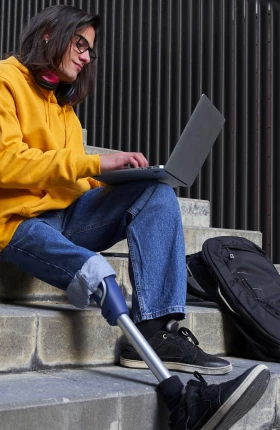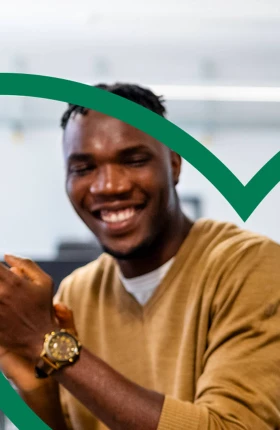Last year, BCG surveyed nearly 28,000 employees from 16 countries across a range of industries and found that one-quarter of the workforce has a disability or health condition that limits a major activity in their lives. According to our research, people with disabilities (PwD) feel less included at work than their non-disabled peers across all countries surveyed—that is, they feel less valued and respected; less likely to feel their opinions matter; less happy, motivated, and filled with a sense of belonging; and less supported mentally and physically. (See “Definitions of Disability.”)
Definitions of Disability
Other entities define disability in similar ways. For example:
- United Nations Convention on the Rights of Persons with Disabilities: “Persons with disabilities include those who have long-term physical, mental, intellectual or sensory impairments which in interaction with various barriers may hinder their full and effective participation in society on an equal basis with others.”
- US Centers for Disease Control and Prevention (CDC): “A disability is any condition of the body or mind (impairment) that makes it more difficult for the person with the condition to do certain activities (activity limitation) and interact with the world around them (participation restrictions).”
- Australian Institute of Health and Welfare: “Disability is an umbrella term for any or all of the following components, all of which may also be influenced by environmental and personal factors: impairment (problems in body function or structure); activity limitation (difficulties in executing activities); or participation restriction (problems an individual may experience in involvement in life situations).”
For simplicity, our report uses the term people with disabilities (PwD). However, people have different terminology preferences when referring to their disability. Some people see their health condition or disability as inherent to their identity and prefer identity-first language, such as deaf person or autistic person. Others prefer person-first language, such as person who is deaf or person with autism. In terms of affiliation, some people prefer to identify themselves as part of the disability community, while others do not see themselves as having a disability and prefer to identify only with their specific condition, such as having a chronic illness or mental health condition or being neurodiverse.
While these findings are meaningful, it’s crucial to acknowledge that PwD are not a monolithic group, and their experiences encompass a broad spectrum. Given the inherent diversity of the disability community represented in the workforce, we sought to delve deeper into the experiences of PwD with other intersecting identities. How might disabled women, BIPOC (Black, Indigenous, people of color), and LGBTQ people experience the workplace in distinct ways?
To answer that question, we took the results of the original survey and analyzed responses from the more than 5,000 employees in the US, where more detailed demographic data was available. This research has led to a deeper understanding of how having additional marginalized identities affects the workplace experiences of PwD. (These subgroups include people who identify as having a marginalized race, gender, and/or sexual orientation profile.)
The original, global research indicated that PwD feel lower levels of inclusion, experience more harassment and discrimination, and feel less psychologically safe in the workplace than people without disabilities. Our new analysis of the US data shows that multimarginalized PwD feel those negative outcomes amplified further and have lower BLISS Index inclusion scores. BCG’s BLISS Index is a comprehensive, statistically rigorous tool that measures employees’ feelings of inclusion, which meaningfully correlate with retention. (See “Methodology” and “BCG’s BLISS Index.”)
Methodology
This research draws upon a survey of approximately 28,000 employees conducted by BCG over the summer and fall of 2022 in 16 countries: Australia, Brazil, China, Denmark, Finland, France, Germany, India, Italy, Japan, Norway, South Africa, Spain, Sweden, UK, and US. Survey respondents were part-time and full-time employees of companies with 1,000 or more employees. The participating companies spanned many industries.
The survey captured self-reported data. For this article, we drew from approximately 1,500 respondents in the US (about 29% of our full US data set) who identified as having a current or periodically occurring health condition, disability, or challenge that limits a major life activity.
BCG’S BLISS Index
To create the BLISS Index, BCG drew upon self-reported data from approximately 28,000 employees in large companies (those with 1,000 or more employees) across 16 countries. We applied statistical modeling to understand what drives feeling of inclusion and identify patterns in the correlations among responses.
The result is a single, comprehensive score ranging from 1 to 100, with higher scores indicating greater feelings of inclusion, a global average score of 65, and normal distribution patterns.
As we demonstrated statistically via BLISS, improving an employee’s feelings of inclusion increases the likelihood that they will stay with the organization. For example, a 5-point increase on the BLISS Index corresponds to an approximately 2.5% reduction in attrition risk. For an organization with 1,000 employees, that translates to 25 employees staying rather than leaving—and taking their expertise and institutional knowledge with them. In today’s environment of low unemployment and costly hiring and training, the economic impact of attrition on organizations can be substantial. BCG’s BLISS Index can help companies reduce this risk.
These findings largely mirror the anecdotal sentiments expressed within these communities. The graphic below highlights key points from the research:

Intersectionality and Disability
While those with a disability face distinct marginalization on average across society (lower health and education outcomes, higher rates of poverty and crime victimhood), PwD who are also members of other marginalized populations are even more disadvantaged—evidence, in part, of structural racism, sexism, anti-LGBTQ stigma, and other systemic inequities in the US.
For example, PwD are victims of violent crime at almost four times the rate of those without disabilities (46.2 per 1,000 versus 12.3 per 1,000), according to the Bureau of Justice Statistics of the US Department of Justice. But within subgroups of people with disabilities, these statistics vary significantly. For PwD who identify as Hispanic, for example, the violent crime rate, at 55.3 per 1,000, is more than 20% higher than for white PwD (45.1 per 1,000) and more than three times higher than for Hispanic people without disabilities (12.3 per 1,000).
When disabilities intersect with other marginalized identities, the workplace experience worsens, too. For employers to effectively address the range of challenges people face at work, they need a deeper understanding of what it means to be a member of more than one marginalized group.
My disability, especially being a woman, was something that made me stand out and be treated differently in a pretty much all-male work environment. —Catherine, publishing
Within the population of PwD in the workplace, our data reveals worsening outcomes when other marginalized identities coincide with disability. These include lower feelings of inclusion and psychological safety. PwD with additional marginalized identities also have their accommodation requests fully met at meaningfully lower rates—particularly BIPOC men and BIPOC women—and experience higher prevalence of workplace harassment and discrimination.
Consider, for example, BIPOC women with disabilities, who face a particularly stark gap in workplace experience. Not only are their BLISS Index scores 5 points lower than the average score for PwD—and 9 points lower than white men with disabilities—they are also 7 percentage points less likely than white women with disabilities to have their requests for accommodations fully met. BIPOC women with disabilities also experience higher rates of discrimination and harassment than other people with disabilities (39% versus 34% for PwD overall) and are 10 percentage points less likely than BIPOC women without disabilities to feel safe making mistakes at work or feel free to be their authentic self at work.
I saw them discriminating against women all the time, and being a Black woman with a disability made it impossible for me to be in that environment. To anyone else, they would be much more supportive or adjusting. I really enjoyed my job, and I hate that I had to leave it because of the environment at work.—Angela, human resources
To learn more about our research findings in the slideshow, navigate through the slides by clicking the right arrow on the screen or by using the right arrow key on your keyboard.
Improving Work Life for Multimarginalized People with Disabilities
In our May 2023 report, “Your Workforce Includes Disability. Does Your People Strategy?,” we offered three concrete measures for employers to put into action: employee-centric policies and programs, mentorship, and accommodations. Looking at these initiatives through the lens of intersectionality, not only are these programs successful among marginalized subgroups, they lift feelings of inclusion (or BLISS Index scores) among all PwD so that they are at the same level—or even higher—than those of nondisabled employees. Activating these measures and tracking their progress also often meaningfully narrows the perceived inclusion gap between the highest- and lowest-scoring subgroups of PwD.
Let’s take a closer look at each of these measures and their impacts.
Offer a wide range of employee-centric programs.
Initiatives that support employees, such as paid parental leave, flexible working arrangements, and employee education opportunities, can make a significant difference in the workplace experience for PwD. At organizations that offer substantial programming (defined as more than 29 employee-centric, DEI programs), PwD have increased feelings of inclusion—even higher than the average employee without a disability.
The availability of substantial programming has a particularly striking impact on multimarginalized subgroups of PwD, markedly reducing or eliminating the gaps in their feelings of inclusion relative to other populations. For example, in workplaces with light programming (fewer than seven programs offered), BIPOC men with disabilities have a BLISS Index score of 49, notably lower than BIPOC men without disabilities (53) and lower than the average score for PwD overall (50). (The global average score is 65.) But substantial programming just about levels the playing field. With it, the score of BIPOC men with disabilities jumps to 76, exceeding BIPOC men without disabilities (75) and reaching parity with the overall average score among people without disabilities (76).
Provide opportunities for mentorship.
Mentorship programs allow less-tenured employees to gain access to guidance, support, and advice from more experienced colleagues. While these programs increase feelings of inclusion across the board, we see an outsize impact for multimarginalized employees with disabilities, fundamentally changing their experience. The BLISS Index score of BIPOC women with disabilities, for example, jumps 10 points for those paired with a mentor. For LGBTQ women with disabilities, mentoring increases their score by 15 points.
In fact, the benefits of being paired with a mentor are even greater for each of the multimarginalized groups we looked at than for their counterparts without disabilities. For instance, while BIPOC women with disabilities see that 10-point increase, BIPOC women without disabilities have an 8-point bump.
In addition to increasing feelings of inclusion, mentors can improve the workplace experience for employees with disabilities by providing practical feedback on job performance, offering advice on navigating difficult conversations, giving tips for managing reasonable accommodation requests and HR processes, and serving as a beacon of support when handling bias.
Making mentorship available is critical, but employers must also push for participation—marketing the program, investigating potential barriers to participation, and working to destigmatize any negative perceptions about needing mentorship.
Meet requests for workplace accommodations.
Across the board, PwD whose requests for accommodation are partially or fully met have higher feelings of inclusion than those whose requests are denied. These requests might include particular equipment or software, flexible working arrangements, or adjustments to their physical environment.
Members of any of these four subgroups with disabilities—BIPOC women, BIPOC men, LGBTQ women, LGBTQ men—whose requests are fully met have BLISS Index scores 10 to 20 points higher than those whose requests are denied. These subgroups also report feelings of inclusion that reach near-parity or even exceed those of their nondisabled counterparts. For example, BIPOC women whose requests are fully met report a BLISS score of 62, within one point of BIPOC women without disabilities—and 18 points higher than BIPOC women with disabilities whose requests were denied.
The fact that they went the extra mile to understand my condition and provide the accommodations I asked for was a testament to their commitment to their employees’ well-being.—Riley, health care
Including the Needs of PwD in Your DEI Strategy
As employers seek to make progress on the state of diversity, equity, and inclusion within their organizations, they must include the diverse experiences of PwD in their efforts. To do so, leaders must build two critical foundations.
Empowered Line Managers
Line managers make a significant difference in the level of inclusion an employee feels, so much so that people whose direct managers aren’t committed to DEI are three times more likely to leave their company—and that’s true among all employees, not just those from underrepresented groups.
Line managers interact with employees on a regular basis and are the most immediate role models for the majority of employees. Their managerial authority gives them enough power to implement, ignore—or even actively undermine—change efforts. They can also influence the psychological safety of the workplace culture, fostering a respectful environment that allows team members to feel comfortable taking risks and sharing perspectives.
Managers need to receive leadership training that focuses on DEI as an ongoing part of their career development path in order to empower and enable adequate support and advocacy for their direct reports, recognizing all the identities their employees hold and how that shapes their workplace experiences.
Building Employee Resource Groups with an Intersectional Approach
BIPOC people overall have a lower BLISS Index inclusion score (63) than white people (65). Those who identify as LGBTQ have a lower score (62) than those who do not (65). These gaps in perceptions of inclusion are good reasons to create employee resource groups (ERGs) and affinity groups, and many organizations do so as a way to support marginalized people in the workplace. But such resources often fail to target the intersectional identities of their members.
We now know that BLISS score gaps increase dramatically when marginalized people also have a disability. The gap between BIPOC people with and without disabilities is twice as large as the gap between BIPOC people and white people overall. Even though ERGs may focus on a single identity, they must be attentive to the needs, challenges, and experiences of members who have disabilities.
We know that people with disabilities feel lower levels of inclusion, experience more harassment and discrimination, and feel less psychologically safe in the workplace than people without disabilities. And this new research spells out even worse experiences for multimarginalized PwD.
Fortunately, employers can develop the tools to turn these outcomes around. Effective programming, resources, accommodations, and overall support for employees with disabilities—pursued through an intentional, equity-focused lens—must be central to a company’s inclusion strategy.
These efforts can make a meaningful difference in the feeling of inclusion, satisfaction, and sense of safety and belonging for a core portion of the workforce, unleashing the potential of employees and powering long-term advantage for the business.












